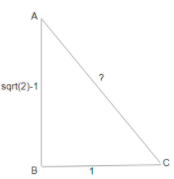Question
Question: Find the principal argument of the complex number \[1 + \sqrt 2 + i\]. Choose the correct option. ...
Find the principal argument of the complex number 1+2+i. Choose the correct option.
A. 3π
B. 6π
C. 8π
D. 4π
Solution
The complex number z is of the form z=x+iy where x represents the real part and y represents the imaginary part. In the given question, z=1+2+i has both real and imaginary parts that is x=1+2 is the real part of the complex number and y=1 is the imaginary part of the given complex number. Use the formula of finding the principal argument of the complex number to find the argument of z. Use the Pythagoras theorem to find the value of θ.
Complete step by step solution:
Consider the given complex number z=x+iy which has both the parts in it. The real part is x=1+2 and the imaginary part is y=1.
We know that, for a complex number z=x+iy, the principal argument of the complex number is given by arg(z)=tan−1(xy).
Next, we will substitute the values in the formula of principal argument of z.
Thus, we get,
arg(1+2+i)=tan−1(1+21)
Now, we will find the value of tan−1(1+21) by multiplying the numerator and denominator by 1−2
Thus, we get,
⇒tan−1(1+21×1−21−2)
Next, we will use the property (a+b)(a−b)=a2−b2 in the denominator.
Hence, we get,
⇒tan−1(1−21−2)=tan−1(2−1)
Now, we will find the value of tan−1(2−1)=θ
⇒tan(θ)=2−1
Consider the figure,

From this we have, AB=2−1 and BC=1 and we have to find the value of AC=?.
Using the Pythagoras theorem, we know that for a ΔABC, (AC)2=(AB)2+(BC)2
Thus, we get,
Now, we have AB=2−1, BC=1 and AC=222−1
Next, we will find the value of sinθ=ACAB and cosθ=ACBC
Thus, we have,
⇒sinθ=222−12−1 and cosθ=222−11
Next, we will evaluate the value of sinθcosθ
Now, multiply 2 on both the sides, we have,
2sinθcosθ=222 sin2θ=21 2θ=4π θ=8πThus, the principal argument arg(1+2+i)=8π.
The option is incorrect as the principal argument is equal to 8π.
Note: The trigonometric identity 2sinθcosθ=sin2θ is used to simplify the expression. Remember the trigonometric values as here we have used
sinA=21 giving A=4π. We have used the Pythagoras theorem in evaluating the value of θ by finding the value of the side of the right-angled triangle.
